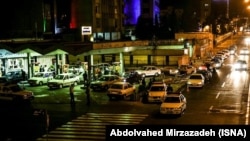Long before being famous for its firebrand hardliners, problematic missile and nuclear programs, chaotic foreign relations and compulsory hijab, Iran was always known as an oil-rich country. Yet the scarcity of gasoline has always been a major problem in the Islamic Republic's domestic energy market.
Like most other things about Iran, there is yet another paradox about gasoline which remains a mystery to some observers. If gasoline supplies are always insufficient because of lack of refining capacity, why over ten million liters of it is smuggled out of Iran on a daily basis? This adds up to 3.65 billion liters every year.
This is only one of many estimates about the smuggling of gasoline from Iran. On December 19, 2018 a government spokesman said everyday 11.5 million liters of gasoline is smuggled out of Iran. Ali Adyani, a member of the Iranian Parliament's Energy Committee has quoted various sources as putting the gasoline smuggling figure at ten, 15 and even 20 million liters a day.
Mohammad Hassan Nejad, another member of the committee, says the smuggled fuel amounts to 22 million liters per day. With a 50 cent per litre profit, the total daily income adds up to 400 trillion rials annually or $3.3 billion, nearly the same as the country's annual development budget.
In addition to gasoline smuggling, other fuels such as kerosene and diesel are also smuggled; not in lesser quantities.
Oil Minister Bijan Zanganeh ruled out that figure, saying it is logistically impossible to carry that much gasoline across the border every day. But all smuggling is not just small-scale wheeling-dealing. At least at certain times fuel smuggling has been a way to circumvent oil export sanctions.
Observers say all of these figures can be true at different times depending on the availability of fuel inside the country and changes in demands in the neighboring countries.
Gasoline and other fossil fuel smuggling takes place in various forms and in many ways, say those who know the market. Most gasoline smugglers are unemployed Iranians who manipulate middle-size vans and minibuses and add two or three fuel tanks with a capacity of up to 500 liters or more to carry gasoline across the borders. They sometimes need to bribe border guards on both sides.
Bigger smugglers, such as a cabinet minister under Iran's ultraconservative President Mahmoud Ahmadinejad (2005-2013), have allegedly used their connections to run convoys of tankers across Iran's northern borders on a daily basis for years, even when Iran imported nearly all of its gasoline due to severe shortage in its refining capacity.
A former police chief was accused at one point of being a ring leader in a widespread network of smuggling gasoline and other fuels. None of these cases have been officially proven in court, but every four years some of the candidates running for President in the past two decades have been accusing each other during of helping their aides smuggle fuel.
According to foreign-based economist Mehrdad Seyed Asgari in an article on Radio Farda's Persian website, the price of one liter of gasoline in Iran is currently about 8 cents while the price in the destination of smuggled fuel in Turkey, Turkmenistan, Azerbaijan, Pakistanis, Iraq, Afghanistan and Armenia is at least 1.23 US dollar. This means that every liter of smuggled fuel brings in a profit of more than a dollar.
The astonishingly low gasoline price in Iran is because the government subsidizes more than 90 percent of the cost; just the opposite of what many other countries do when they heavily tax fuels to reduce consumption.
The devaluation of the Iranian currency in the past one year has made gasoline at least three times cheaper in dollars. That has made smuggling even a more profitable venture.
Another problem is that this subsidy comes out of the country’s wealth but mainly benefits those who have a car and can afford to drive a lot. The richest 10 percent of the Iranian population benefits from the subsidy 11 times more than the poorest ten percent.
In 2016, 43 percent of Iranian families had gasoline fuelled cars. The other 53 percent do not own a car, so they do not benefit from the gasoline subsidy. The shocking reality is that the richest urban families own at least one car while only one percent of the poorest rural families have a vehicle.
A major part of the problem is systematic smuggling and systematic corruption. The government believes between 30 to 40 million liters of fuel, including 10 million liters of gasoline is smuggled across the border every day.
Not all of that fuel is handled by individual smugglers. Rural institutions and industrial units benefiting from gigantic quotas for subsidized gasoline and other fuels channel them into the smuggling market.
The security problem involved in fuel smuggling is that countries under financial sanctions, such as Iran, can turn it into mechanism to circumvent sanctions.
To what extent Iran’s fuel smuggling is a centrally organized venture, is hard to say, but potentially it could be a way to turn some of the oil wealth into hard cash, despite U.S. sanctions on its oil exports. During the previous round of international sanctions, it was widely reported that Iran was helping to smuggle fuels to regional countries to secure some income.
This could explain why after forty years of smuggling gasoline the problem is still there without any solution in sight.






